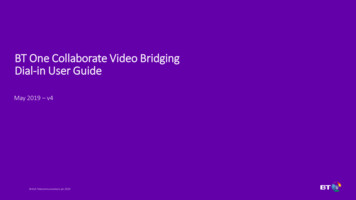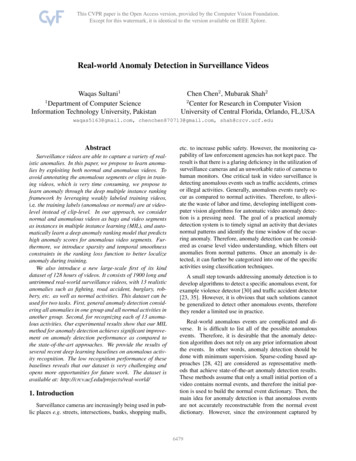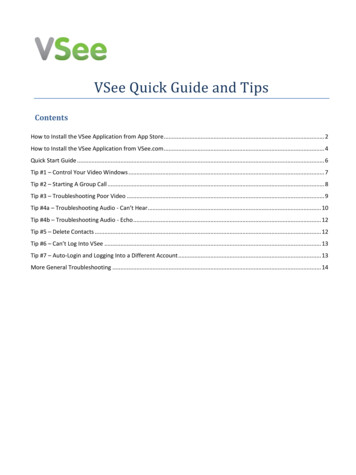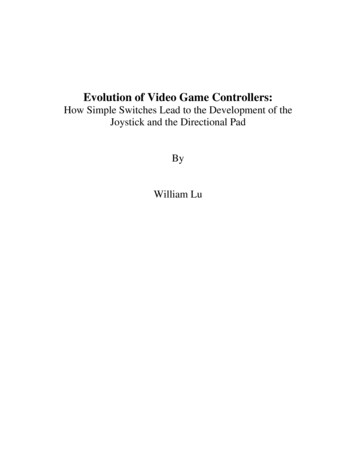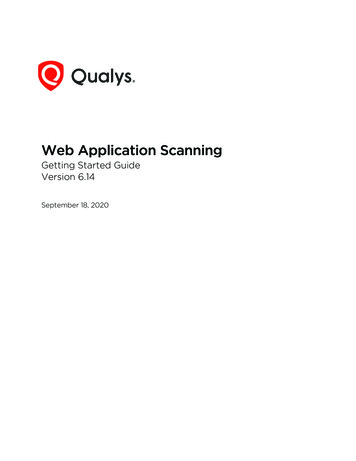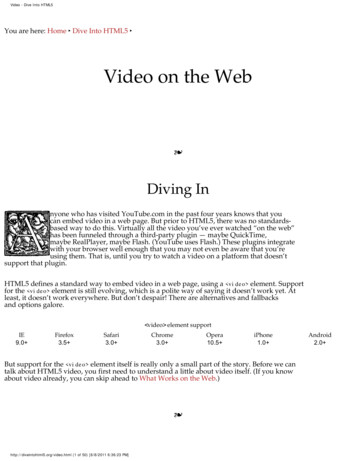
Transcription
Video - Dive Into HTML5You are here: Home ‣ Dive Into HTML5 ‣Video on the Web Diving Innyone who has visited YouTube.com in the past four years knows that youcan embed video in a web page. But prior to HTML5, there was no standardsbased way to do this. Virtually all the video you’ve ever watched “on the web”has been funneled through a third-party plugin — maybe QuickTime,maybe RealPlayer, maybe Flash. (YouTube uses Flash.) These plugins integratewith your browser well enough that you may not even be aware that you’reusing them. That is, until you try to watch a video on a platform that doesn’tsupport that plugin.HTML5 defines a standard way to embed video in a web page, using a video element. Supportfor the video element is still evolving, which is a polite way of saying it doesn’t work yet. Atleast, it doesn’t work everywhere. But don’t despair! There are alternatives and fallbacksand options galore. video element supportIE9.0 Firefox3.5 Safari3.0 Chrome3.0 Opera10.5 iPhone1.0 But support for the video element itself is really only a small part of the story. Before we cantalk about HTML5 video, you first need to understand a little about video itself. (If you knowabout video already, you can skip ahead to What Works on the Web.) http://diveintohtml5.org/video.html (1 of 50) [6/8/2011 6:36:23 PM]Android2.0
Video - Dive Into HTML5Video ContainersYou may think of video files as “AVI files” or “MP4 files.” In reality, “AVI” and “MP4″ arejust container formats. Just like a ZIP file can contain any sort of file within it, videocontainer formats only define how to store things within them, not what kinds of data are stored.(It’s a little more complicated than that, because not all video streams are compatible withall container formats, but never mind that for now.)A video file usually contains multiple tracks — a video track (without audio), plus one ormore audio tracks (without video). Tracks are usually interrelated. An audio track containsmarkers within it to help synchronize the audio with the video. Individual tracks canhave metadata, such as the aspect ratio of a video track, or the language of an audiotrack. Containers can also have metadata, such as the title of the video itself, cover art for thevideo, episode numbers (for television shows), and so on.There are lots of video container formats. Some of the most popular includeMPEG 4, usually with an .mp4 or .m4v extension. The MPEG 4 container is based on Apple’solder QuickTime container (.mov). Movie trailers on Apple’s website still use the olderQuickTime container, but movies that you rent from iTunes are delivered in an MPEG 4 container. Flash Video, usually with an .flv extension. Flash Video is, unsurprisingly, used by AdobeFlash. Prior to Flash 9.0.60.184 (a.k.a. Flash Player 9 Update 3), this was the only containerformat that Flash supported. More recent versions of Flash also support the MPEG 4 container. Ogg, usually with an .ogv extension. Ogg is an open standard, open source–friendly,and unencumbered by any known patents. Firefox 3.5, Chrome 4, and Opera 10.5 support— natively, without platform-specific plugins — the Ogg container format, Ogg video(called “Theora”), and Ogg audio (called “Vorbis”). On the desktop, Ogg is supported out-ofthe-box by all major Linux distributions, and you can use it on Mac and Windows by installingthe QuickTime components or DirectShow filters, respectively. It is also playable with theexcellent VLC on all platforms. WebM is a new container format. It is technically similar to another format, calledMatroska. WebM was announced in May, 2010. It is designed to be used exclusively with theVP8 video codec and Vorbis audio codec. (More on these in a minute.) It is supportednatively, without platform-specific plugins, in the latest versions of Chromium, GoogleChrome, Mozilla Firefox, and Opera. Adobe has also announced that a future version of Flashwill support WebM video. Audio Video Interleave, usually with an .avi extension. The AVI container format wasinvented by Microsoft in a simpler time, when the fact that computers could play video at allwas considered pretty amazing. It does not officially support features of more recentcontainer formats like embedded metadata. It does not even officially support most of themodern video and audio codecs in use today. Over time, companies have tried to extend itin generally incompatible ways to support this or that, and it is still the default container formatfor popular encoders such as MEncoder. Video Codecshttp://diveintohtml5.org/video.html (2 of 50) [6/8/2011 6:36:23 PM]
Video - Dive Into HTML5When you talk about “watching a video,” you’re probably talking about a combination of onevideo stream and one audio stream. But you don’t have two different files; you just have“the video.” Maybe it’s an AVI file, or an MP4 file. These are just container formats, like a ZIPfile that contains multiple kinds of files within it. The container format defines how to storethe video and audio streams in a single file.When you “watch a video,” your video player is doing at least three things at once:1. Interpreting the container format to find out which video and audio tracks are available,and how they are stored within the file so that it can find the data it needs to decode next2. Decoding the video stream and displaying a series of images on the screen3. Decoding the audio stream and sending the sound to your speakersA video codec is an algorithm by which a video stream is encoded, i.e. it specifies how to do #2above. (The word “codec” is a portmanteau, a combination of the words “coder” and“decoder.”) Your video player decodes the video stream according to the video codec, then displaysa series of images, or “frames,” on the screen. Most modern video codecs use all sorts of tricksto minimize the amount of information required to display one frame after the next. Forexample, instead of storing each individual frame (like a screenshot), they will only storethe differences between frames. Most videos don’t actually change all that much from one frameto the next, so this allows for high compression rates, which results in smaller file sizes.There are lossy and lossless video codecs. Lossless video is much too big to be useful on the web,so I’ll concentrate on lossy codecs. A lossy video codec means that information is beingirretrievably lost during encoding. Like copying an audio cassette tape, you’re losinginformation about the source video, and degrading the quality, every time you encode. Insteadof the “hiss” of an audio cassette, a re-re-re-encoded video may look blocky, especiallyduring scenes with a lot of motion. (Actually, this can happen even if you encode straight fromthe original source, if you choose a poor video codec or pass it the wrong set of parameters.) Onthe bright side, lossy video codecs can offer amazing compression rates by smoothingover blockiness during playback, to make the loss less noticeable to the human eye.There are tons of video codecs. The three most relevant codecs are H.264, Theora, and VP8.H.264H.264 is also known as “MPEG-4 part 10,” a.k.a. “MPEG-4 AVC,” a.k.a. “MPEG-4 AdvancedVideo Coding.” H.264 was also developed by the MPEG group and standardized in 2003. It aimsto provide a single codec for low-bandwidth, low-CPU devices (cell phones); high-bandwidth,high-CPU devices (modern desktop computers); and everything in between. To accomplish this,the H.264 standard is split into “profiles,” which each define a set of optional features thattrade complexity for file size. Higher profiles use more optional features, offer better visualquality at smaller file sizes, take longer to encode, and require more CPU power to decode inreal-time.To give you a rough idea of the range of profiles, Apple’s iPhone supports Baseline profile,the AppleTV set-top box supports Baseline and Main profiles, and Adobe Flash on a desktopPC supports Baseline, Main, and High profiles. YouTube now uses H.264 to encode highdefinition videos, playable through Adobe Flash; YouTube also provides H.264-encoded videoto mobile devices, including Apple’s iPhone and phones running Google’s Androidhttp://diveintohtml5.org/video.html (3 of 50) [6/8/2011 6:36:23 PM]
Video - Dive Into HTML5mobile operating system. Also, H.264 is one of the video codecs mandated by the BluRay specification; Blu-Ray discs that use it generally use the High profile.Most non-PC devices that play H.264 video (including iPhones and standalone Blu-Rayplayers) actually do the decoding on a dedicated chip, since their main CPUs are nowherenear powerful enough to decode the video in real-time. These days, even low-end desktopgraphics cards support decoding H.264 in hardware. There are competing H.264encoders, including the open source x264 library. The H.264 standard is patentencumbered; licensing is brokered through the MPEG LA group. H.264 video can be embeddedin most popular container formats, including MP4 (used primarily by Apple’s iTunes Store)and MKV (used primarily by non-commercial video enthusiasts).TheoraTheora evolved from the VP3 codec and has subsequently been developed by the Xiph.org Foundation. Theora is a royalty-free codec and is not encumbered by any knownpatents other than the original VP3 patents, which have been licensed royalty-free. Althoughthe standard has been “frozen” since 2004, the Theora project (which includes an opensource reference encoder and decoder) only released version 1.0 in November 2008 and version1.1 in September 2009.Theora video can be embedded in any container format, although it is most often seen in anOgg container. All major Linux distributions support Theora out-of-the-box, and Mozilla Firefox3.5 includes native support for Theora video in an Ogg container. And by “native”, Imean “available on all platforms without platform-specific plugins.” You can also playTheora video on Windows or on Mac OS X after installing Xiph.org’s open source decoder software.VP8VP8 is another video codec from On2, the same company that originally developed VP3(later Theora). Technically, it produces output on par with H.264 High Profile, while maintaininga low decoding complexity on par with H.264 Baseline.In 2010, Google acquired On2 and published the video codec specification and a sampleencoder and decoder as open source. As part of this, Google also “opened” all the patents thatOn2 had filed on VP8, by licensing them royalty-free. (This is the best you can hope forwith patents. You can’t actually “release” them or nullify them once they’ve been issued. Tomake them open source–friendly, you license them royalty-free, and then anyone can usethe technologies the patents cover without paying anything or negotiating patent licenses.) Asof May 19, 2010, VP8 is a royalty-free, modern codec and is not encumbered by anyknown patents, other than the patents that On2 (now Google) has already licensed royalty-free. Audio Codecshttp://diveintohtml5.org/video.html (4 of 50) [6/8/2011 6:36:23 PM]
Video - Dive Into HTML5Unless you’re going to stick to films made before 1927 or so, you’re going to want an audio trackin your video. Like video codecs, audio codecs are algorithms by which an audio stream isencoded. Like video codecs, there are lossy and lossless audio codecs. And like losslessvideo, lossless audio is really too big to put on the web. So I’ll concentrate on lossy audio codecs.Actually, it’s even narrower than that, because there are different categories of lossy audiocodecs. Audio is used in places where video is not (telephony, for example), and there is anentire category of audio codecs optimized for encoding speech. You wouldn’t rip a music CDwith these codecs, because the result would sound like a 4-year-old singing into aspeakerphone. But you would use them in an Asterisk PBX, because bandwidth is precious,and these codecs can compress human speech into a fraction of the size of general-purposecodecs. However, due to lack of support in both native browsers and third-party plugins,speech-optimized audio codecs never really took off on the web. So I’ll concentrate ongeneral purpose lossy audio codecs.As I mentioned earlier, when you “watch a video,” your computer is doing at least three thingsat once:1. Interpreting the container format2. Decoding the video stream3. Decoding the audio stream and sending the sound to your speakersThe audio codec specifies how to do #3 — decoding the audio stream and turning it intodigital waveforms that your speakers then turn into sound. As with video codecs, there are allsorts of tricks to minimize the amount of information stored in the audio stream. And sincewe’re talking about lossy audio codecs, information is being lost during the recording encoding decoding listening lifecycle. Different audio codecs throw away different things, but theyall have the same purpose: to trick your ears into not noticing the parts that are missing.One concept that audio has that video does not is channels. We’re sending sound to yourspeakers, right? Well, how many speakers do you have? If you’re sitting at your computer, youmay only have two: one on the left and one on the right. My desktop has three: left, right, andone more on the floor. So-called “surround sound” systems can have six or morespeakers, strategically placed around the room. Each speaker is fed a particular channel ofthe original recording. The theory is that you can sit in the middle of the six speakers,literally surrounded by six separate channels of sound, and your brain synthesizes them andfeels like you’re in the middle of the action. Does it work? A multi-billion-dollar industry seemsto think so.Most general-purpose audio codecs can handle two channels of sound. During recording, thesound is split into left and right channels; during encoding, both channels are stored in thesame audio stream; during decoding, both channels are decoded and each is sent to theappropriate speaker. Some audio codecs can handle more than two channels, and they keep trackof which channel is which and so your player can send the right sound to the right speaker.There are lots of audio codecs. Did I say there were lots of video codecs? Forget that. There aregobs and gobs of audio codecs, but on the web, there are really only three you need to knowabout: MP3, AAC, and Vorbis.MPEG-1 Audio Layer 3http://diveintohtml5.org/video.html (5 of 50) [6/8/2011 6:36:23 PM]
Video - Dive Into HTML5MPEG-1 Audio Layer 3 is colloquially known as “MP3.” If you haven’t heard of MP3s, I don’tknow what to do with you. Walmart sells portable music players and calls them “MP3players.” Walmart. Anyway MP3s can contain up to 2 channels of sound. They can be encoded at different bitrates: 64 kbps,128 kbps, 192 kbps, and a variety of others from 32 to 320. Higher bitrates mean larger file sizesand better quality audio, although the ratio of audio quality to bitrate is not linear. (128 kbpssounds more than twice as good as 64 kbps, but 256 kbps doesn’t sound twice as good as 128kbps.) Furthermore, the MP3 format allows for variable bitrate encoding, which means that someparts of the encoded stream are compressed more than others. For example, silence betweennotes can be encoded at a low bitrate, then the bitrate can spike up a moment later whenmultiple instruments start playing a complex chord. MP3s can also be encoded with aconstant bitrate, which, unsurprisingly, is called constant bitrate encoding.The MP3 standard doesn’t define exactly how to encode MP3s (although it does define exactlyhow to decode them); different encoders use different psychoacoustic models that producewildly different results, but are all decodable by the same players. The open source LAME projectis the best free encoder, and arguably the best encoder period for all but the lowest bitrates.The MP3 format (standardized in 1991) is patent-encumbered, which explains why Linux can’tplay MP3 files out of the box. Pretty much every portable music player supports standaloneMP3 files, and MP3 audio streams can be embedded in any video container. Adobe Flash canplay both standalone MP3 files and MP3 audio streams within an MP4 video container.Advanced Audio CodingAdvanced Audio Coding is affectionately known as “AAC.” Standardized in 1997, it lurchedinto prominence when Apple chose it as their default format for the iTunes Store. Originally,all AAC files “bought” from the iTunes Store were encrypted with Apple’s proprietaryDRM scheme, called FairPlay. Selected songs in the iTunes Store are now available asunprotected AAC files, which Apple calls “iTunes Plus” because it sounds so much betterthan calling everything else “iTunes Minus.” The AAC format is patent-encumbered;licensing rates are available online.AAC was designed to provide better sound quality than MP3 at the same bitrate, and it canencode audio at any bitrate. (MP3 is limited to a fixed number of bitrates, with an upper boundof 320 kbps.) AAC can encode up to 48 channels of sound, although in practice no one doesthat. The AAC format also differs from MP3 in defining multiple profiles, in much the same wayas H.264, and for the same reasons. The “low-complexity” profile is designed to be playable inreal-time on devices with limited CPU power, while higher profiles offer better sound quality atthe same bitrate at the expense of slower encoding and decoding.All current Apple products, including iPods, AppleTV, and QuickTime support certain profilesof AAC in standalone audio files and in audio streams in an MP4 video container. AdobeFlash supports all profiles of AAC in MP4, as do the open source MPlayer and VLC videoplayers. For encoding, the FAAC library is the open source option; support for it is a compiletime option in mencoder and ffmpeg.Vorbishttp://diveintohtml5.org/video.html (6 of 50) [6/8/2011 6:36:23 PM]
Video - Dive Into HTML5Vorbis is often called “Ogg Vorbis,” although this is technically incorrect. (“Ogg” is just acontainer format, and Vorbis audio streams can be embedded in other containers.) Vorbis isnot encumbered by any known patents and is therefore supported out-of-the-box by allmajor Linux distributions and by portable devices running the open source Rockboxfirmware. Mozilla Firefox 3.5 supports Vorbis audio files in an Ogg container, or Ogg videos witha Vorbis audio track. Android mobile phones can also play standalone Vorbis audio files.Vorbis audio streams are usually embedded in an Ogg or WebM container, but they can alsobe embedded in an MP4 or MKV container (or, with some hacking, in AVI). Vorbis supportsan arbitrary number of sound channels.There are open source Vorbis encoders and decoders, including OggConvert (encoder),ffmpeg (decoder), aoTuV (encoder), and libvorbis (decoder). There are also QuickTimecomponents for Mac OS X and DirectShow filters for Windows. What Works on the WebIf your eyes haven’t glazed over yet, you’re doing better than most. As you can tell, video(and audio) is a complicated subject — and this was the abridged version! I’m sureyou’re wondering how all of this relates to HTML5. Well, HTML5 includes a video elementfor embedding video into a web page. There are no restrictions on the video codec, audio codec,or container format you can use for your video. One video element can link to multiple videofiles, and the browser will choose the first video file it can actually play. It is up to you toknow which browsers support which containers and codecs.As of this writing, this is the landscape of HTML5 video:Mozilla Firefox (3.5 and later) supports Theora video and Vorbis audio in an Oggcontainer. Firefox 4 also supports WebM. Opera (10.5 and later) supports Theora video and Vorbis audio in an Ogg container. Opera10.60 also supports WebM. Google Chrome (3.0 and later) supports Theora video and Vorbis audio in an Oggcontainer. Google Chrome 6.0 also supports WebM. Safari on Macs and Windows PCs (3.0 and later) will support anything that QuickTimesupports. In theory, you could require your users to install third-party QuickTime plugins.In practice, few users are going to do that. So you’re left with the formats that QuickTimesupports “out of the box.” This is a long list, but it does not include WebM, Theora, Vorbis, orthe Ogg container. However, QuickTime does ship with support for H.264 video (main profile)and AAC audio in an MP4 container. Mobile phones like Apple’s iPhone and Google Android phones support H.264 video(baseline profile) and AAC audio (“low complexity” profile) in an MP4 container. Adobe Flash (9.0.60.184 and later) supports H.264 video (all profiles) and AAC audio (allprofiles) in an MP4 container. Internet Explorer 9 supports all profiles of H.264 video and either AAC or MP3 audio in anMP4 container. It will also play WebM video if you install a third-party codec, which is notinstalled by default on any version of Windows. IE9 does not support other third-partycodecs (unlike Safari, which will play anything QuickTime can play). Internet Explorer 8 has no HTML5 video support at all, but virtually all Internet Explorer http://diveintohtml5.org/video.html (7 of 50) [6/8/2011 6:36:23 PM]
Video - Dive Into HTML5users will have the Adobe Flash plugin. Later in this chapter, I’ll show you how you canuse HTML5 video but gracefully fall back to Flash.That might be easier to digest in table form.Video codec support in shipping browsersCodecs/containerTheora Vorbis OggH.264 AAC MP4WebMIE Firefox Safari Chrome Opera iPhone Android·3.5 †5.0 10.5 ····3.0 5.0–?‡·3.0 2.0 ··†6.0 10.6 ··† Safari will play anything that QuickTime can play. QuickTime comes pre-installed with H.264/AAC/MP4 support.There are installable third-party plugins that add support for Theora and WebM, but each user needs to install theseplugins before Safari will recognize those video formats.‡ Google Chrome will drop support for H.264 soon. Read about why.A year from now, the landscape will look significantly different as WebM is implementedin multiple browsers, those browsers ship non-experimental WebM-enabled versions, andusers upgrade to those new versions.Video codec support in upcoming browsersCodecs/containerTheora Vorbis OggH.264 AAC MP4WebMIE·9.0 9.0 *Firefox Safari Chrome Opera iPhone Android3.5 †5.0 10.5 ···3.0 ··3.0 2.0 4.0 †6.0 10.6 ·2.3‡* Internet Explorer 9 will only support WebM “when the user has installed a VP8 codec,” which implies that Microsoftwill not be shipping the codec themselves.† Safari will play anything that QuickTime can play, but QuickTime only comes with H.264/AAC/MP4 support pre-installed.‡ Although Android 2.3 supports WebM, there are no hardware decoders yet, so battery life is a concern.And now for the knockout punch:Professor Markup SaysThere is no single combination of containers and codecs that works in all HTML5 browsers.This is not likely to change in the near future.To make your video watchable across all of these devices and platforms, you’re going to need toencode your video more than once.For maximum compatibility, here’s what your video workflow will look like:1. Make one version that uses WebM (VP8 Vorbis).2. Make another version that uses H.264 baseline video and AAC “low complexity” audio inan MP4 container.3. Make another version that uses Theora video and Vorbis audio in an Ogg container.http://diveintohtml5.org/video.html (8 of 50) [6/8/2011 6:36:23 PM]
Video - Dive Into HTML54. Link to all three video files from a single video element, and fall back to a Flash-basedvideo player. Licensing Issues with H.264 VideoBefore we continue, I need to point out that there is a cost to encoding your videos twice.Well, there’s the obvious cost, that you have to encode your videos twice, and that takesmore computers and more time than just doing it once. But there’s another real cost associatedwith H.264 video: licensing costs.Remember when I first explained H.264 video, and I mentioned offhand that the video codecwas patent-encumbered and licensing was brokered by the MPEG LA consortium. That turns outto be kind of important. To understand why it’s important, I direct you to The H.264Licensing Labyrinth:MPEG LA splits the H.264 license portfolio into two sublicenses: one for manufacturers of encodersor decoders and the other for distributors of content. The sublicense on the distribution side gets further split out to four key subcategories, two of which(subscription and title-by-title purchase or paid use) are tied to whether the end user pays directlyfor video services, and two of which (“free” television and internet broadcast) are tied toremuneration from sources other than the end viewer. The licensing fee for “free” television is based on one of two royalty options. The first is a one-timepayment of 2,500 per AVC transmission encoder, which covers one AVC encoder “used by or onbehalf of a Licensee in transmitting AVC video to the End User,” who will decode and view it. Ifyou’re wondering whether this is a double charge, the answer is yes: A license fee has already beencharged to the encoder manufacturer, and the broadcaster will in turn pay one of the two royaltyoptions.The second licensing fee is an annual broadcast fee. [T]he annual broadcast fee is broken downby viewership sizes: 2,500 per calendar year per broadcast markets of 100,000–499,999 television households 5,000 per calendar year per broadcast market of 500,000–999,999 television households 10,000 per calendar year per broadcast market of 1,000,000 or more television households With all the issues around “free” television, why should someone involved in nonbroadcastdelivery care? As I mentioned before, the participation fees apply to any delivery of content. Afterdefining that “free” television meant more than just [over-the-air], MPEG LA went on to defineparticipation fees for internet broadcasting as “AVC video that is delivered via the WorldwideInternet to an end user for which the end user does not pay remuneration for the right to receive orview.” In other words, any public broadcast, whether it is [over-the-air], cable, satellite, or theinternet, is subject to participation fees. http://diveintohtml5.org/video.html (9 of 50) [6/8/2011 6:36:23 PM]
Video - Dive Into HTML5The fees are potentially somewhat steeper for internet broadcasts, perhaps assuming that internetdelivery will grow much faster than OTA or “free” television via cable or satellite. Adding the “freetelevision” broadcast-market fee together with an additional fee, MPEG LA grants a reprieve ofsorts during the first license term, which ends on Dec. 31, 2010, and notes that “after the first termthe royalty shall be no more than the economic equivalent of royalties payable during the same timefor free television.”That last part — about the fee structure for internet broadcasts — has already been amended.The MPEG-LA recently announced that internet streaming would not be charged. That doesnot mean that H.264 is royalty-free for all users. In particular, encoders (like the one thatprocesses video uploaded to YouTube) and decoders (like the one included in MicrosoftInternet Explorer 9) are still subject to licensing fees. See Free as in smokescreen formore information. Encoding Video WithMiro Video ConverterThere are many tools for encoding video, and there are many video encoding options thataffect video quality. If you do not wish to take the time to understand anything aboutvideo encoding, this section is for you.Miro Video Converter is an open source, GPL-licensed program for encoding video inmultiple formats. Download it for Mac OS X or Windows. It supports all the outputformats mentioned in this chapter. It offers no options beyond choosing a video file and choosingan output format. It can take virtually any video file as input, including DV video producedby consumer-level camcorders. It produces reasonable quality output from most videos. Due toits lack of options, if you are unhappy with the output, you have no recourse but to tryanother program.To start, just launch the Miro Video Converter application.Miro Video Converter main screenhttp://diveintohtml5.org/video.html (10 of 50) [6/8/2011 6:36:23 PM]
Video - Dive Into HTML5Click “Choose file” and select the source video you want to encode.“Choose file”http://diveintohtml5.org/video.html (11 of 50) [6/8/2011 6:36:23 PM]
Video - Dive Into HTML5The “Pick a Device or Video Format” dropdown menu lists a variety of devices and formats. Forthe purposes of this chapter, we are only interested in three of them.1. WebM (vp8) is WebM video (VP8 video and Vorbis audio in a WebM container).2. Theora is Theora video and Vorbis audio in an Ogg container.3. iPhone is H.264 Baseline Profile video and AAC low-complexity audio in an MP4 container.Select “WebM” first.Choosing WebM outputhttp://diveintohtml5.org/video.html (12 of 50) [6/8/2011 6:36:23 PM]
Video - Dive Into HTML5Click the “Convert” button and Miro Video Converter will immediately start encoding yourvideo. The output file will be named SOURCEFILE.webm and will be saved in the same directory asthe source video.You’ll be staring at this screenfor a long time http://diveintohtml5.org/video.html (13 of 50) [6/8/2011 6:36:23 PM]
Video - Dive Into HTML5Once the encoding is complete, you’ll be dumped back to the main screen. This time,select “Theora” from the Devices and Formats list.Time for Theorahttp://diveintohtml5.org/video.html (14 of 50) [6/8/2011 6:36:23 PM]
Video - Dive Into HTML5That’s it; press the “Convert” button again to encode your Theora video. The video will benamed SOURCEFILE.theora.ogv and will be saved in the same directory as the source video.Time for a cup of coffeehttp://diveintohtml5.org/video.html (15 of 50) [6/8/2011 6:36:23 PM]
Video - Dive Into HTML5Finally, encode your iPhone-compatible H.264 video by selecting “iPhone” from the Devicesand Formats list.iPhone, not iPhone 4http://diveintohtml5.org/video.htm
Video - Dive Into HTML5 mobile operating system. Also, H.264 is one of the video codecs mandated by the Blu-Ray specification; Blu-Ray discs that use it generally use the High profile. Most non-PC devices that p



